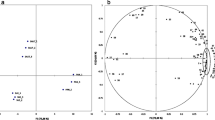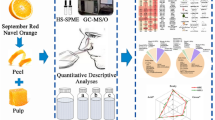Abstract
Variation in the volatiles, total polyphenol, theobromine and caffein was investigated both qualitatively and quantitatively for all phases of conching with GC/MS/SPME, HPLC, GC/O, and UV-visible spectrophotometry. The volatile compounds being identified during the three phases consisted of aldehydes, ketones, pyrazines, acids, alcohols and esters. The number and concentration of these compounds were observed to be 31–25,681 ppb, 44–34,838 ppb and 44–29,809 ppb in the dry, pasty, and liquid phases respectively. The odor of dark chocolate was described as nutty, sweet, caramel, green and chocolate using olfactometry. The percent decrease in the concentration of total polyphenol, caffein and theobromine was observed to be only 3.0, 11.0, and 32.0 respectively.
Similar content being viewed by others
References
Afoakwa EO, Paterson A, Fowler M (2007) Factor influencing rheological and textural qualities in chovolate-review. Trends in Food Science& Technology 18:290–298
Akhtar Y, Yang Y, Isman MB, Plettner E (2010) Dialkoxybenzene and dialkoxy-allylbenzene feeding and oviposition deterrents against the cabbage looper, trichoplusia ni: potential insect behavior control agents. J Agric Food Chem 58:4983–4991
AOAC, 1990 Offical Methods of Analysis Vol 2. 15th edition Aspects of Official Analysis Chemistry, Inc. Arlington, VA
Arora A, Byrem TM, Nair MG, Strasburg GM (2000) Modulation of liposomal membrane fluidity by flavonoids and isoflavonoids. Arch Biochem Biophys 373:102–109
Awua PK (2002) Cocoa processing and chocolate manufacture in Ghana. David Jamieson and associates Pres. Inc, Essex, UK
Beckett ST (2009) Industrial chocolate manufacture and use 4 th Ed. U.K, Wiley-Blackwell, York, p. 192
Beckett ST (2000) The science of chocolate. Royal Society of Chemistry Paperbacks
Beckett ST (2003) Is the taste of British milk chocolate different? International J. Dairy Tech. 56(3):139–142
Benowitz NL (1990) Clinical pharmacology of caffeine. Annu Rev Med 41:277–288
Counet C, Callemien D, Ouwerx C, Collin S (2002) Use of gas chromotograpy-olfactometry to identify key odorant compound in dark chocolate. Comprasion of Sample before and After Conching J Agric Food Chem 5:2385–2391
Frauendorfer F, Schieberle P (2006) Identification of the key aroma compound in cocoa powder based on molecular sensory correlations. Journal of agricultural and food chemistry. Vol. 54:5521–5529
Hoskin J, Dimick P (1983) Role of nonenzymatic browning during the process of chcolate- a review. Process Biochem 11:92–104
Keeney PG (1971) Various interactions in chocolate flavour. J Am Oil Chem Soc 49(10):567
Minifie BW (1989) Chocolate, cocoa and confectionery- science and technology. Chapman&Hall, London
Nehlig A, Daval JL, Debry G (1992) Caffeine and the central nervous system: mechanisms of action, biochemical, metabolic and psychostimulant effects. Brain Res Rev 17(2):139–170
Ramli N, Hassan O, Said M, Samsudin W, Idris NA (2006) Influence of roasting condition on volatile flavour of roasted Malaysian cocoa beans. J. Food Proc. Pres. 30(3):280–298
Reineccius G (2006) Flavour chemistry and technology, Second edn. CRC Pres, Boca Raton, USA
Schnermann P, Schieberle P (1997) Evaluation of key odourants in milk chocolate and cocoa mass by aroma extract dilution analyses. J Agric Food Chem 45:867–872
Shamsuddin, S. B. and Dimick, P. S. 1986. Qualitative and quantitative measurement of cacao bean fermentation. In Dimmick, P.S., Proceeding of the symposium Cacao Biotechnology, pp. 55–78. The Pennsylvania State University.
Singleton VL, Rossi JA (1965) Colorimetry of total phenolics with phosphomolybdic-phosphotungstic acid reagents. Am J Enol Vitic 16:144–153
Spiller GA (1998) Caffeine content of some cola beverages. In: Spiller G (ed) Caffeine. CRC Press LLC., Boca Raton, FL, p. 363
Steinberg FM, Bearden MM, Keen CL (2003) Cocoa and chocolate flavonoids: implications for cardiovascular health. J Am Diet Assoc 103:215–223
Whitefield R (2005) Making chocolates in the factory. Kennefy’s Publications Ltd, London UK
Wollgast J, Anklam E (2000) Food Res Int 33:449
Author information
Authors and Affiliations
Corresponding author
Rights and permissions
About this article
Cite this article
Albak, F., Tekin, A. Variation of total aroma and polyphenol content of dark chocolate during three phase of conching. J Food Sci Technol 53, 848–855 (2016). https://doi.org/10.1007/s13197-015-2036-4
Revised:
Accepted:
Published:
Issue Date:
DOI: https://doi.org/10.1007/s13197-015-2036-4




